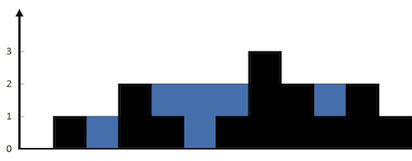Given n non-negative integers representing an elevation map where the width of each bar is 1, compute how much water it is able to trap after raining.
For example,
Given [0,1,0,2,1,0,1,3,2,1,2,1], return 6.

有很多种思路~
- 暴力解…算每个位置上下雨后可以装多高的水
- dp,把从左至右和从右至左最高的bar存起来
- 栈,我想到的直观思路
- 双指针,似乎是更快的思路,直观理解是,对于每一个位置i来说,其上的水量受制于左右两边最高的bar的最小的值(max-min),然后,区别与2那么暴力地去保存最高值,这边是通过双指针搜索的方式来获取。简单来说,就是不断更新左右两边的最高bar
双指针的思路!!!增加一个左右两边的“壁垒”,思路很巧妙!
class Solution {
public int trap(int[] height) {
if(height.length == 0)return 0;
int left = 0;
int right = height.length - 1;
int leftMax = height[left];
int rightMax = height[right];
int ret = 0;
while(left < right){
if(height[left] < height[right]){
ret+= Math.min(leftMax,rightMax) - height[left];
left++;
leftMax = Math.max(height[left],leftMax);
}else{
ret+= Math.min(rightMax,leftMax) - height[right];
right--;
rightMax = Math.max(height[right],rightMax);
}
}
return ret;
}
}
栈的思路,核心难点在于恢复整个过程
class Solution {
public int trap(int[] height) {
Deque<Integer> stack = new ArrayDeque<>();
int ret = 0;
for(int i = 0; i<height.length;){
if(stack.isEmpty() || height[stack.peek()] >= height[i])stack.push(i++);
else{
int left = stack.pop();
int add = stack.isEmpty()?
0: (Math.min(height[stack.peek()],height[i]) - height[left])*(i - stack.peek() - 1);
ret+=add;
}
}
return ret;
}
}





 博客围绕给定非负整数表示的柱状图,计算雨后积水量展开。介绍了多种算法思路,包括暴力解、动态规划(dp)、栈和双指针法。其中双指针法通过搜索获取左右最高bar,思路巧妙;栈思路的核心难点在于恢复过程。
博客围绕给定非负整数表示的柱状图,计算雨后积水量展开。介绍了多种算法思路,包括暴力解、动态规划(dp)、栈和双指针法。其中双指针法通过搜索获取左右最高bar,思路巧妙;栈思路的核心难点在于恢复过程。
















 311
311

 被折叠的 条评论
为什么被折叠?
被折叠的 条评论
为什么被折叠?








